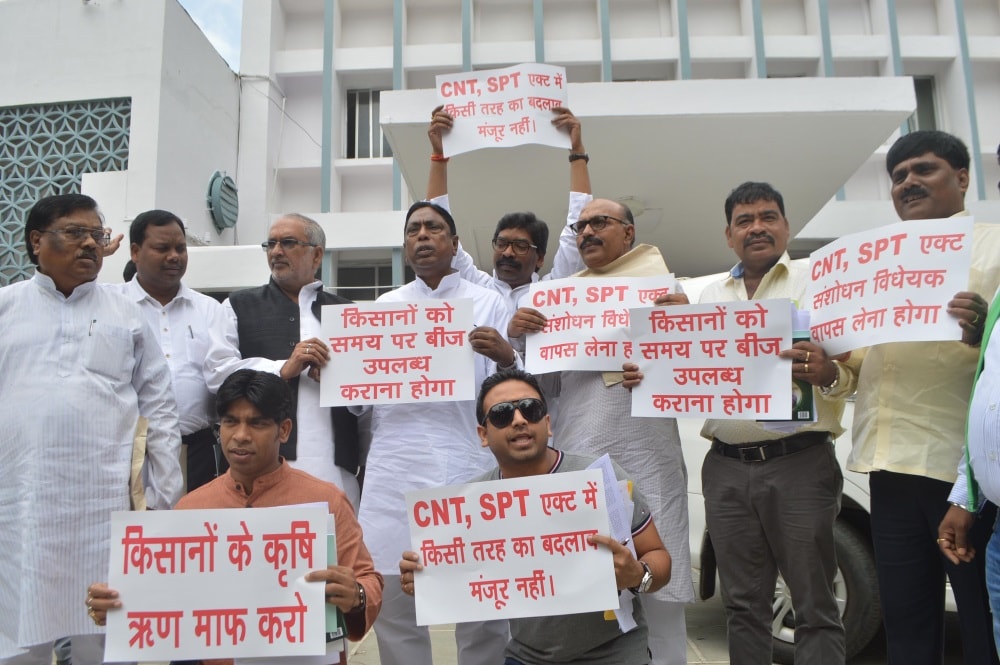

*Picture shows Opposition members shout slogans and hold placards during their protest against Governments CNT/SPT Act during first day of Monsoon session at Jharkhand Assembly in Ranchi on Tuesday.
Scores of Adivasis held a meeting across Jharkhand in an attempt to unite against the Raghubar Das government’s move to introduce forcible conversion bill on floor of the monsoon session of the Assembly beginning Wednesday.
The Adivasi dominated villages have become a hot spot for meetings and discussions on the government’s decision taken by the Cabinet headed by the CM Das.The Adivasi groups belonging to both Sarna(non Hindu tribals) and Christian tribals were opposed to the move,it is learnt.
The Kendriya Sarna Samiti and Christian Committees who held a meeting at Ideal Lane in Fatima Nagar in Ranchi have separately resolved to celebrate the 10th anniversary of the International Indigenous day on August 9.The Kendriya Sarna Samiti headed by its president Ajay Tirkey has mobilized Adivasis to march from Zila School ground in Ranchi to Morahabadi maidan on Wednesday.
Even the opposition parties,especially the Congress and the JMM have picked up the forcible conversion bill and amendment of tenancy laws(CNT/SPT) lodged protest against the government inside the premise of the Jharkhand Assembly today.The monsoon session is slayed to end on August 12,2017.
Notably,the Congress which is suffering from intra- party feud and leadership crisis aims to mobilise supporters among Adivasis by organizing first of its kind agitation- block all approach roads to the Assembly as part of their House Gherao agitation.
In any case, opposition parties have also raised three other issues to lodge protest:deterioration in law and order,farmer suicide cases and crime against women.Their leaders were keeping vigil over the Adivasi groups busy observing 10th anniversary of the International Indigenous day.
As it is,there are an as many as 370 million indigenous people in the world, living across 90 countries. Many tribals consider themselves as ‘Indigenous people.’All of them make up less than 5 per cent of the world's population, but account for 15 per cent of the poorest people of the world.
“Indigenous peoples are inheritors and practitioners of unique cultures and ways of relating to people and the environment. They have retained social, cultural, economic and political characteristics that are distinct from those of the dominant societies in which they live. Despite their cultural differences, indigenous peoples from around the world share common problems related to the protection of their rights as distinct peoples.
Indigenous peoples have sought recognition of their identities, way of life and their right to traditional lands, territories and natural resources for years, yet throughout history their rights have always been violated. Indigenous peoples today, are arguably among the most disadvantaged and vulnerable groups of people in the world. The international community now recognizes that special measures are required to protect their rights and maintain their distinct cultures and way of life”,said a report.
2017 Theme:
Ten years ago, on 13 September 2007, the General Assembly adopted the United Nations Declaration on the Rights of Indigenous Peoples, a major milestone with respect to the cooperation and solidarity between indigenous peoples and Member States.
The Declaration is the most comprehensive international instrument on the rights of indigenous peoples. It embodies global consensus on the rights of indigenous peoples and establishes a universal framework of minimum standards for their survival, dignity and well-being. It elaborates on existing human rights standards and fundamental freedoms, as they apply to the specific situation of indigenous peoples.
Over the last decade, the implementation of the Declaration has achieved some major successes in at the national, regional and international levels. Despite the achievements, there continues to be a gap between the formal recognition of indigenous peoples and the implementation of policies on the ground.